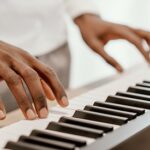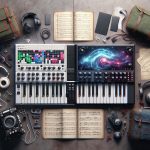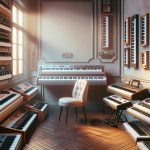Embarking on the journey to learn piano basics can be thrilling yet daunting. It all starts with finding the perfect keyboard that not only fits your budget but also makes learning enjoyable and effective. With countless options out there, it's easy to feel overwhelmed.
That's where we come in. We've sifted through the noise to bring you the top keyboards that are ideal for beginners. Whether you're looking for something portable, budget-friendly, or packed with learning features, we've got you covered. Let's dive into the world of music together and find the keyboard that'll set the stage for your musical journey.
Key Considerations for Choosing a Keyboard
When diving into the world of piano, selecting the right keyboard is a crucial step that can significantly impact a learner's journey. A well-chosen keyboard not only makes the learning process more pleasant but also helps in mastering the basics with greater ease. Here are some essential factors to consider when choosing the best keyboard for learning piano basics.
Size and Key Weight play a pivotal role in transitioning to an acoustic piano in the future. Beginners should look for keyboards with 88 keys and weighted action to mimic the feel of a traditional piano. This not only aids in finger strength development but also ensures a more authentic playing experience.
Sound Quality is another vital aspect. A good keyboard should offer a sound that is as close to an acoustic piano as possible. High-quality samples and a decent speaker system can make practice sessions more enriching and enjoyable for beginners.
Learning Features such as built-in lessons, light-up keys, and integration with learning apps can significantly enhance the learning experience. These features provide an interactive platform, making it easier for beginners to grasp complex concepts and techniques.
Connectivity options are often overlooked but are essential for a modern music learning experience. A keyboard with MIDI or USB ports allows learners to connect with music software and apps, offering a broader range of learning materials and opportunities to record and edit their performances.
Below is a comparison of three popular beginner keyboards, showcasing their key features:
| Keyboard Model | Key Size and Weight | Sound Quality Features | Learning Features | Connectivity |
|---|---|---|---|---|
| Yamaha P125 | 88 weighted keys | Pure CF Sound Engine | Duo mode for side-by-side learning | USB to Host |
| Casio CTK-2550 | 61 touch-sensitive keys | AHL sound source | Step-up learning system | No MIDI |
| Roland GO:PIANO | 61 full-size keys | Roland’s acclaimed piano sounds | Bluetooth MIDI for apps | Bluetooth Audio/MIDI |
Accessibility should not be overlooked. Keyboards are available at a range of price points, so it’s important to find one that offers the best value for one's budget. Investing in a slightly higher-priced model might offer better long-term value due to enhanced features and durability.
Portable Keyboards for On-the-Go Learning

In today's fast-paced world, the ability to learn on the move has become increasingly important. For those embarking on their piano learning journey, portable keyboards offer the perfect solution. These instruments are designed to provide flexibility and convenience, allowing students to practice anytime and anywhere. Lightweight and often compact, portable keyboards can easily be transported, making them ideal for travelers or individuals with limited space.
One of the key benefits of portable keyboards is their versatility. Despite their smaller size, many of these keyboards come equipped with a range of features similar to their full-sized counterparts. This includes a variety of voices, built-in rhythms, and even recording capabilities. For beginners, this means they don't have to compromise on the quality of their practice sessions, regardless of where they are.
Key Considerations for Choosing a Portable Keyboard
When selecting a portable keyboard for learning piano basics, several factors come into play:
- Size and Number of Keys: Most portable keyboards have fewer than 88 keys. However, for beginners, a 61-key keyboard is often sufficient to start learning the basics. It's compact yet offers enough range for initial lessons.
- Weighted Keys: While rare in highly portable models, finding a keyboard with semi-weighted keys can provide a closer feel to an acoustic piano. This feature is crucial for developing proper finger strength and technique.
- Battery Operation: The ability to run on batteries is a must-have for a truly portable keyboard. It ensures that learners can practice even in places without easy access to power outlets.
- Learning Tools: Integrated learning systems, such as built-in lessons or connectivity with smartphone apps, enhance the learning experience on the go.
Top Picks for Portable Keyboards
To help narrow down the choices, here are three recommended portable keyboards for beginners:
| Keyboard Model | Number of Keys | Key Type | Battery Operated | Additional Features |
|---|---|---|---|---|
| Yamaha PSR-E263 | 61 | Unweighted | Yes | 400 voices, 130 styles |
| Casio CTK-2550 | 61 | Unweighted | Yes | 400 tones, 150 rhythms, Dance Music Mode |
| Roland GO:KEYS | 61 | Semi-weighted | Yes | Bluetooth connectivity, Loop Mix Function |
Budget-Friendly Options without Compromising Quality

Finding a budget-friendly keyboard that doesn’t cut corners on quality is crucial for beginners who are just embarking on their musical journey. Affordability doesn't have to mean compromise, especially when it comes to learning the piano basics. There are several options out there that provide a great learning experience without breaking the bank.
First up, it’s important to note that weighted keys play a significant role in simulating the feel of an acoustic piano. Fortunately, some budget keyboards offer semi-weighted or touch-sensitive keys that come close to this experience while remaining cost-effective. Additionally, having built-in learning tools like lesson modes and song libraries can make practice sessions more engaging and productive.
Here’s a quick comparison of three budget-friendly keyboards that are perfect for beginners:
| Keyboard Model | Number of Keys | Key Type | Battery Operated | Additional Features |
|---|---|---|---|---|
| Yamaha PSR-E273 | 61 | Touch Sensitive | Yes | Learning mode, 400 voices |
| Casio CTK-2550 | 61 | Touch Responsive | Yes | Step-up learning system, Dance Music Mode |
| Alesis Recital | 88 | Semi-Weighted | No | 5 voices, Educational Features |
Each of these models offers a great balance between price and features, making them ideal for learners who are serious about picking up the essentials of piano playing without spending too much upfront. The Yamaha PSR-E273, for instance, includes a learning mode that breaks down songs into smaller, manageable parts, aiding beginners in grasping the basics more effectively. On the other hand, the Casio CTK-2550’s Dance Music Mode can make practice sessions more fun and engaging, offering learners a break from traditional exercises without stepping away from the keyboard.
The Alesis Recital stands out for its 88 semi-weighted keys, providing an experience closer to that of an acoustic piano. This makes it an excellent choice for students who are ready to transition to more serious practice but are still looking for an affordable option. While not battery operated, its comprehensive educational features justify its place in a learner’s arsenal, especially for those prioritizing the feel of the keys.
Key Learning Features to Look for in a Beginner Keyboard

Choosing the right keyboard for learning piano basics means looking beyond just the price and the number of keys. It's about pinpointing the learning features that can genuinely enhance a beginner's journey from novice to skilled pianist. These features not only make learning more interactive but also ensure that the process is engaging and efficient. Here are some pivotal learning features to consider:
Built-in Lessons and Modes
Many beginner keyboards come with pre-loaded lessons that guide users through the basics of piano playing, from reading music to finger positioning. These lessons are particularly beneficial as they allow learners to practice at their own pace without the constant need for a teacher's presence. Keyboards equipped with various playing modes - such as the split mode, which divides the keyboard into two halves, allowing teacher and student to play side by side – offer valuable hands-on experience. This feature is instrumental in helping beginners understand timing and harmony in a practical setting.
Touch Sensitivity
While it might seem like a feature reserved for more expensive models, touch sensitivity is crucial for beginners. It makes a keyboard respond differently to the force used to press the keys, closely mimicking the dynamics of an acoustic piano. This helps learners develop a nuanced touch and better control of their dynamics early on. Playing on a touch-sensitive keyboard encourages students to focus on the expression and emotion in their playing, not just the notes they hit.
Recording and Playback
The ability to record and playback performances is invaluable for learners. This feature assists beginners in evaluating their playing, identifying areas for improvement, and tracking their progress over time. By listening to themselves, students can catch nuances and mistakes in their performances that they might not notice while playing.
Metronome and Other Tools
A built-in metronome is a must-have for any beginner keyboard. It helps learners keep a steady tempo - a foundational skill in music that supports everything from practicing scales to performing complex pieces. Additionally, keyboards that offer visual aids such as LED lights that guide finger placement or display on-screen sheet music can significantly reduce the learning curve for beginners.
Top Picks for the Best Keyboards for Learning Piano Basics

When starting the journey of learning piano basics, the right keyboard can make all the difference. With the plethora of options available, finding the perfect fit that aligns with a beginner's needs might feel daunting. However, there are a few standout models that are frequently recommended by music teachers and seasoned pianists alike for their comprehensive learning features and quality.
The Yamaha PSR-E363 is often at the top of many lists. It's well-loved for its touch-sensitive keys, which mimic the response of an acoustic piano, allowing for expressive play. This keyboard also shines with its built-in lessons covering a wide range of styles and techniques, offering beginners a solid foundation in music theory and practice. Its ability to connect to a computer or mobile device for expanded learning with apps is a significant plus.
Another great option is the Casio CTK-2550. It doesn't skimp on learning features despite its affordable price tag. The Step-Up Lesson System is ideal for beginners, breaking down songs into smaller, learnable parts. Additionally, the 400 onboard tones and 150 rhythms provide ample opportunities for experimentation and developing musical ear.
For those looking for something that closely mimics the feel of an acoustic piano, the Roland GO:PIANO is a fantastic choice. It boasts 88 full-size keys with standard spacing and real piano feel, thanks to its high-quality keyboard action. The Roland GO:Piano also offers Bluetooth connectivity for using with educational apps and a minimalistic interface that keeps learners focused on playing rather than navigating complicated menus.
No discussion about beginner keyboards would be complete without mentioning the Alesis Recital. It's a feature-packed model with 88 semi-weighted keys offering adjustable touch response. Beginners will appreciate the lesson modes that divide the keyboard into two zones with the same pitch and voice. This is especially helpful for side-by-side practice sessions. The Alesis Recital also provides an impressive range of sounds and built-in effects to play with, letting students explore various musical genres and styles.
Here's a quick comparison of the key features of these top picks:
| Model | Key Count | Key Type | Built-in Lessons | Touch Sensitivity | Connectivity Options |
|---|---|---|---|---|---|
| Yamaha PSR-E363 | 61 | Touch-Sensitive |
Conclusion
Choosing the right keyboard to start your piano journey is crucial. The Yamaha PSR-E363, Casio CTK-2550, Roland GO:PIANO, and Alesis Recital each offer unique features tailored to beginners. Whether it's touch-sensitive keys for a more dynamic playing experience, built-in lessons to guide your practice, or connectivity options for interactive learning, these keyboards are designed to make your introduction to piano as enriching and enjoyable as possible. It's about finding the one that best suits your learning style and musical aspirations. With any of these top picks, you're well on your way to mastering the basics and beyond.
Harlan Kilstein began playing piano during covid with no piano background at all. He taught himself how to play learning what to do and what not to do.
Today he's an advanced intermediate player and can help you grow in your skills because he learned all this on his own.







